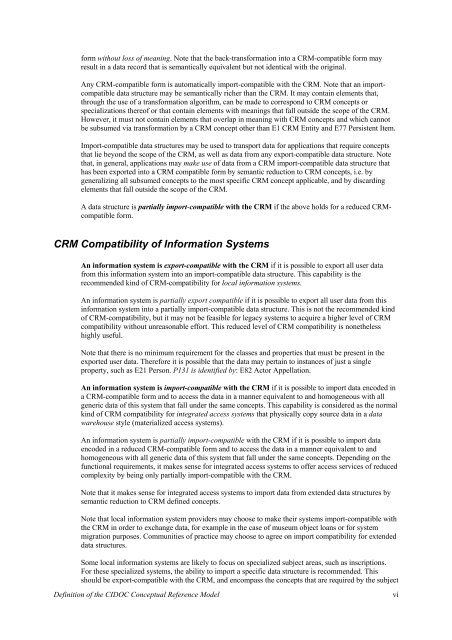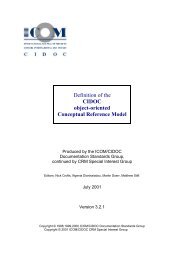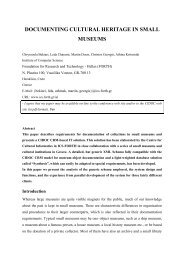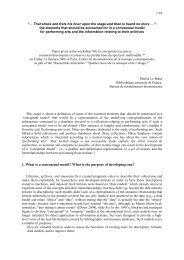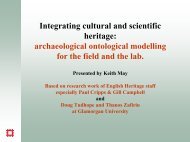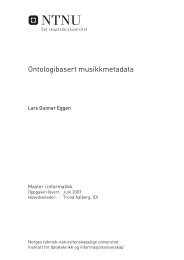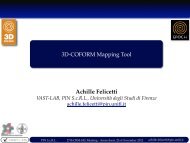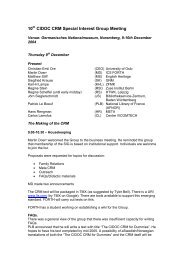pdf file - The CIDOC CRM
pdf file - The CIDOC CRM
pdf file - The CIDOC CRM
You also want an ePaper? Increase the reach of your titles
YUMPU automatically turns print PDFs into web optimized ePapers that Google loves.
form without loss of meaning. Note that the back-transformation into a <strong>CRM</strong>-compatible form may<br />
result in a data record that is semantically equivalent but not identical with the original.<br />
Any <strong>CRM</strong>-compatible form is automatically import-compatible with the <strong>CRM</strong>. Note that an importcompatible<br />
data structure may be semantically richer than the <strong>CRM</strong>. It may contain elements that,<br />
through the use of a transformation algorithm, can be made to correspond to <strong>CRM</strong> concepts or<br />
specializations thereof or that contain elements with meanings that fall outside the scope of the <strong>CRM</strong>.<br />
However, it must not contain elements that overlap in meaning with <strong>CRM</strong> concepts and which cannot<br />
be subsumed via transformation by a <strong>CRM</strong> concept other than E1 <strong>CRM</strong> Entity and E77 Persistent Item.<br />
Import-compatible data structures may be used to transport data for applications that require concepts<br />
that lie beyond the scope of the <strong>CRM</strong>, as well as data from any export-compatible data structure. Note<br />
that, in general, applications may make use of data from a <strong>CRM</strong> import-compatible data structure that<br />
has been exported into a <strong>CRM</strong> compatible form by semantic reduction to <strong>CRM</strong> concepts, i.e. by<br />
generalizing all subsumed concepts to the most specific <strong>CRM</strong> concept applicable, and by discarding<br />
elements that fall outside the scope of the <strong>CRM</strong>.<br />
A data structure is partially import-compatible with the <strong>CRM</strong> if the above holds for a reduced <strong>CRM</strong>compatible<br />
form.<br />
<strong>CRM</strong> Compatibility of Information Systems<br />
An information system is export-compatible with the <strong>CRM</strong> if it is possible to export all user data<br />
from this information system into an import-compatible data structure. This capability is the<br />
recommended kind of <strong>CRM</strong>-compatibility for local information systems.<br />
An information system is partially export compatible if it is possible to export all user data from this<br />
information system into a partially import-compatible data structure. This is not the recommended kind<br />
of <strong>CRM</strong>-compatibility, but it may not be feasible for legacy systems to acquire a higher level of <strong>CRM</strong><br />
compatibility without unreasonable effort. This reduced level of <strong>CRM</strong> compatibility is nonetheless<br />
highly useful.<br />
Note that there is no minimum requirement for the classes and properties that must be present in the<br />
exported user data. <strong>The</strong>refore it is possible that the data may pertain to instances of just a single<br />
property, such as E21 Person. P131 is identified by: E82 Actor Appellation.<br />
An information system is import-compatible with the <strong>CRM</strong> if it is possible to import data encoded in<br />
a <strong>CRM</strong>-compatible form and to access the data in a manner equivalent to and homogeneous with all<br />
generic data of this system that fall under the same concepts. This capability is considered as the normal<br />
kind of <strong>CRM</strong> compatibility for integrated access systems that physically copy source data in a data<br />
warehouse style (materialized access systems).<br />
An information system is partially import-compatible with the <strong>CRM</strong> if it is possible to import data<br />
encoded in a reduced <strong>CRM</strong>-compatible form and to access the data in a manner equivalent to and<br />
homogeneous with all generic data of this system that fall under the same concepts. Depending on the<br />
functional requirements, it makes sense for integrated access systems to offer access services of reduced<br />
complexity by being only partially import-compatible with the <strong>CRM</strong>.<br />
Note that it makes sense for integrated access systems to import data from extended data structures by<br />
semantic reduction to <strong>CRM</strong> defined concepts.<br />
Note that local information system providers may choose to make their systems import-compatible with<br />
the <strong>CRM</strong> in order to exchange data, for example in the case of museum object loans or for system<br />
migration purposes. Communities of practice may choose to agree on import compatibility for extended<br />
data structures.<br />
Some local information systems are likely to focus on specialized subject areas, such as inscriptions.<br />
For these specialized systems, the ability to import a specific data structure is recommended. This<br />
should be export-compatible with the <strong>CRM</strong>, and encompass the concepts that are required by the subject<br />
Definition of the <strong>CIDOC</strong> Conceptual Reference Model<br />
vi


